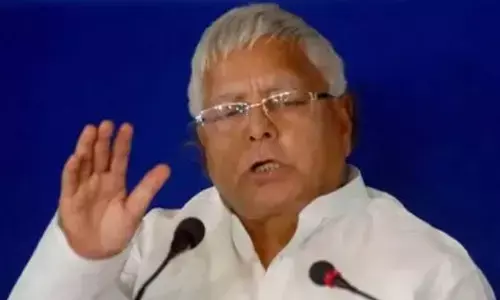Multiple factors gives nuke power major push in APAC region: Moody's

Moody's
A combination of factors like the move towards decarbonization, fuel diversification, geopolitical situations resulting in fossil fuel price hike and climate change affecting solar and wind power provide the base for expansion of nuclear power in the Asia Pacific region, said Moody's Investors Service.
Chennai: A combination of factors like the move towards decarbonization, fuel diversification, geopolitical situations resulting in fossil fuel price hike and climate change affecting solar and wind power provide the base for expansion of nuclear power in the Asia Pacific region, said Moody's Investors Service.
"Decarbonisation and fuel diversification will drive the nuclear power sector's share of the energy mix in Asia Pacific," said Ada Li, a Moody's Vice President, and Senior Credit Officer.
"Recent disruptions, such as a spike in fuel fossil prices because of the Russia-Ukraine war, and less stable solar and wind performance due to climate conditions, also underpin a greater role for nuclear power in the region's long-term carbon transition plans," added Li.
According to Moody's nuclear power will maintain its 10 per cent share of the global energy mix through 2050, supported by an expanding APAC fleet.
Around 60 per cent of new nuclear units under construction globally were in APAC as of the end of April 2023.
Nuclear power share of APAC's energy mix will rise from current levels of 5 per cent to 8 per cent by 2050, Moody's said.
The stability of nuclear power output - compared to solar and wind power -- increases its cost competitiveness among low-carbon energy options. Recent disruptions, including from the Russia-Ukraine war and climate conditions, have further increased the appeal of nuclear power.
China, Japan, and Korea will lead APAC's nuclear power expansion with plans to increase the sector's share in their power mix to more than double-digit percentages.
China is the largest builder of nuclear units globally, with the aim to double the share of nuclear power in its energy mix by 2035. Surging fuel costs and tight supply have driven Japan's policy shift to nuclear, with more restarts planned. South Korea relies heavily on nuclear power, with nuclear to contribute 35 per cent of total power in the country by 2036
According to the report, technological advances for safer, structurally reinforced and climate resilient reactors, the gradual commissioning of new generation reactors without material cost overruns and delays, and the provision of safe waste disposal and decommissioning plans should help alleviate policy hurdles and public concerns about nuclear power.
Moody's said new nuclear power capacity additions, primarily spearheaded by Asia, together with a more open attitude to nuclear power to meet net-zero targets in markets like the UK, will offset retirements and exits of nuclear in markets such as Germany.
There have been announcements of lifetime extensions of existing reactors in developed markets that originally had plans to exit nuclear power, such as Belgium, the report said.
As regards the number of nuclear power units currently under construction in the APAC region, China leads with 19 units totaling 19,805 MW and is followed by India 8 units, 6,028 MW; Korea 3 units, 4,200 MW; Japan 3 units, 4,038 MW; and Bangladesh 2 units, 2,160 MW.
The credit rating agency said construction delays and cost overruns are common in first-of-a-kind projects, especially under tightened safety requirements for new generation reactors.
For example, the European Pressurized Reactor (EPR), a third generation nuclear power technology, its debut unit in Finland, Olkiluoto 3, experienced multiple delays and cost overruns. The plant, whose construction began in 2005, started commercial operations only at the beginning of 2023, some 14 years past its original commissioning date.
The EPR at Flamanville in France is planning for commercial operation, estimated to cost over 12 billion euros, compared with its original budget of around 3 billion euros. Although China's EPRs at Taishan took shorter time to commission, it still took nearly nine years to complete construction and connect to the grid, Moody's said.
In India, the 500 MW Prototype Fast Breeder Reactor (PFBR) is getting delayed for various reasons. The reactor is first of its kind for India and designed by the Indira Gandhi Centre for Atomic Research ((IGCAR).
"Continuous policy support in the research and development of new civilian nuclear power technologies (for example, small modular reactors (SMRs)) will enhance the long-term competitiveness of nuclear power and cultivate the technical expertise of staff," Moodya�s said.
SMRs are nuclear reactors that have a power capacity of up to 300 MW per unit, which is about one-third of the generating capacity of traditional nuclear reactors.
They are intended to have lower initial investment and a shorter construction time than traditional reactors because of their smaller scale, components that can be factory assembled and transported, and lower site requirements.
On the other hand, wider application of SMRs is constrained by their overall economics after incorporating infrastructure costs, for example grid connection.
Currently there are 50 SMRs globally, most being pilot reactors or reactors constructed for academic research purposes. Wider application of commercially viable SMR technologies will be beneficial to long-term nuclear development because, given the smaller scale investment required, they will more likely attract private investors and therefore make it easier to obtain financing, said Moody's.
That apart countries like China, India, Japan, and others are developing or exploring thorium-based nuclear reactors as an alternative to uranium, with thorium over three times more abundant than uranium. However, extraction costs remain high and there are other challenges in terms of handling the materials and waste.
















